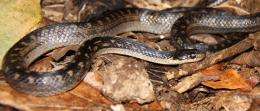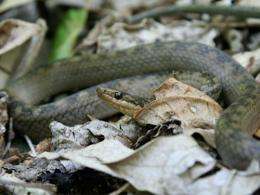The Saint Lucia racer takes the title of world's rarest snake

Conservationists have found the world’s rarest known snake in the Caribbean nation of Saint Lucia. A five-month assessment of the Saint Lucia racer, a small non-venomous snake, has revealed that as few as 18 individuals remain. The racer was once common across Saint Lucia, but rapidly declined after predatory mongooses were introduced to Saint Lucia from India in the late 19th century. The last Saint Lucia racers now survive only on a single offshore islet just 12 hectares (30 acres) in size, which has remained mongoose-free.
The Saint Lucia racer, one of four endemic snakes of Saint Lucia, was declared extinct in 1936. However, in 1973, a single individual was caught on Maria Islands Nature Reserve. Since then, sightings have been rare, leading to fears that these harmless snakes may have been lost forever.
Towards the end of 2011, a team of Saint Lucian and international conservationists was assembled to find out whether the racers still survived and, with funding from the Balcombe Trust, the Disney Worldwide Conservation Fund and the US Fish & Wildlife Service, began painstaking searches of the rocky, steep-sided islet. Eleven racers were caught, tagged with microchips and released unharmed. Analysis of data from recaptures indicate a total population of only 18 individuals. Another, less conservative method placed the population at nearer 100.
The Saint Lucia racer is therefore deemed to be the rarest known snake in the world and indeed one of the rarest animals of any kind. At only 12 hectares, its distribution range is also one of the smallest of any snake.

“Durrell has been committed to working with Saint Lucia’s most threatened species for the last 30 years and so it was a huge relief to confirm that a population of the racer still survives,” says Matthew Morton, Eastern Caribbean Programme Manager for Durrell Wildlife Conservation Trust, “but that relief is tempered by the knowledge of how close we still are to losing it forever.”
The title of the “world’s rarest snake” was previously held by a different West Indian snake, the Antiguan racer. In 1995, the Antiguan racer numbered only 50 individuals, but after 17 years of conservation efforts by the Antiguan Racer Conservation Project, these racers have increased to a more secure population of 900 individuals. This success has been achieved by building local understanding and pride in the snake and removing the non-native mongooses and rats that prey on snakes. This strategy is now being investigated closely by the conservation team in Saint Lucia to determine whether the Saint Lucia racer can be saved using a similar approach. Until then, the tiny population, found on only one tiny island, remains under severe threat of extinction.
“We have four endemic snakes species unique to Saint Lucia,” says Alwin Dornelly, Wildlife Officer at the Saint Lucia Forestry Department, “one of them extremely rare. We have to ensure we make every effort to save this important species from extinction.”
Bishnu Tulsie, director of The Saint Lucia National Trust says, “we welcome confirmation that the Saint Lucia Racer is still present on Maria Major and will collaborate with partners to implement measures to improve chances for its survival.
”Tens if not hundreds of West Indian animals have already been lost because humans have unwisely released harmful species from other parts of the world, and we cannot allow the gentle Saint Lucia racer to be the next casualty,” said Dr. Jenny Daltry, Senior Conservation Biologist with Fauna & Flora International, adding, “To do nothing is not an option.”
Provided by Fauna & Flora International


















